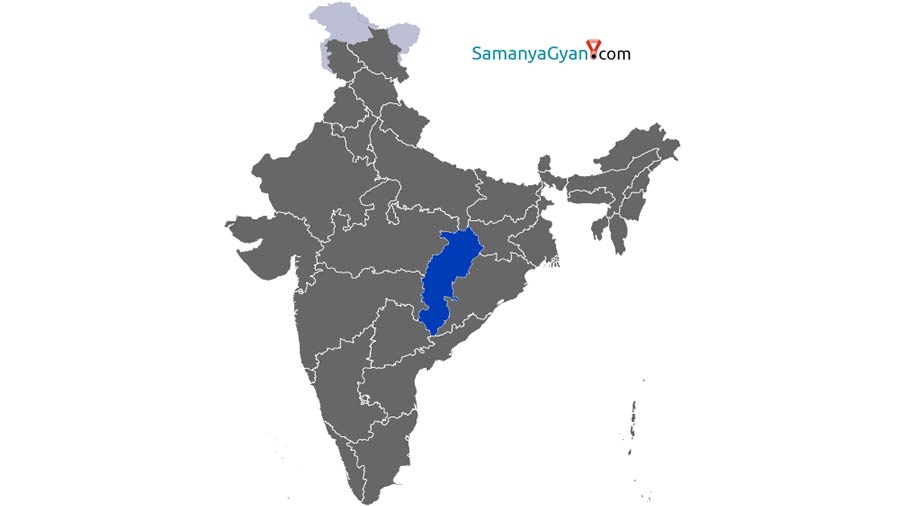Through this chapter, we will know the detailed and important information of Chhattisgarh, in which important and interesting information like history, geography, economy, education, culture and world famous tourist places located in the state have been added. Apart from this, the recent developments and changes in the state of Chhattisgarh have also been explained in detail. This chapter is full of interesting facts for the competitive aspirants as well as the readers.
Quick General Knowledge
| State Level | State |
| Capital | Raipur (Executive Branch), Bilaspur |
| Statehood | 1 November 2000 |
| Largest City | Raipur, Bilaspur |
| Total Area | 1,35,192 sq km |
| Districts | 27 |
| Current Chief Minister | Bhupesh Bhagel |
| Current Governor | Vishwabhushan Harichandan |
| State Bird | Common hill myna |
| State Flower | Rhynchostylis gigantea |
| State Animal | Wild water buffalo |
| State Tree | Sal tree |
| Languages | Chhattisgarhi and Hindi |
| State Dance | Gaur Maria, Panthi, Raut Nacha, Pandwani, Vedamati, Kapalik, Chandaini, Bharthari Charit, Goudi, Karma, Jhumar, Dagla, Pali, Tapali, Navrani, Diwari, Mundari and Jhumar. |
Chhattisgarh (छत्तीसगढ़)
Chhattisgarh is India's 26th state. The state of Chhattisgarh was formed on 01 November 2000. The capital of this state is Raipur and its High Court is at Bilaspur. The total area of Chhattisgarh is 135,191 sq km which is just 30% of Madhya Pradesh. Terrain constitutes 4.14% of the total territory of India. Chhattisgarh is the 9th largest state in the country in terms of area. This state ranks 17th in terms of population. There are a total of 27 districts in Chhattisgarh.
The Legislative Assembly of Chhattisgarh has 90 members. From this state, 11 members go to the Lok Sabha and five members to the Rajya Sabha.
The current Chief Minister of Chhattisgarh is Bhupesh Baghel. He was sworn in as the Chief Minister of the state on 17 December 2018. Ajit Jogi was the first person to become the Chief Minister of Chhattisgarh. He was sworn in as the first Chief Minister of the state on 01 November 2000.
The current governor of Chhattisgarh is Ansuiya Uike. Ansuiya Uike is sworn in as the Governor of Chhattisgarh on 29 July 2019.
80 percent of the population here cultivates agriculture. The main farming season here is Kharif. Rice is the main crop here. Due to the rich yields of paddy, it is also called the rice bowl and is supplied to 600 rice mills from here. It produces 14 quintals of paddy per hectare. Other important crops of the state are maize, wheat, raw grains, groundnut and pulses. Korea is one of the main regions of the state of Chhattisgarh, where maize is cultivated the most.
Chhattisgarh is one of the states rich in natural resources of India. Its forest revenue is 44 percent of the total forest revenue of the state. It has abundant deposits of limestone, iron-ore, copper ore, rock phosphate, manganese ore, bauxite, coal, asbestos and mica. Agriculture is the main activity of the people in this state surrounded by Madhya Pradesh, Uttar Pradesh, Bihar, Odisha, Andhra Pradesh and Maharashtra. 80 per cent of the population here does agriculture. Steel and electricity are the major industries of the state. 15 percent of the country's steel is produced in Chhattisgarh.
At the time of the formation of the state of Chhattisgarh, there were only 16 districts, but now Chhattisgarh has a total of 27 districts. The state has the following 27 districts: -
Kawardha District, Kanker District (Uttar Bastar), Korba District, Koriya District, Jashpur District, Janjgir-Champa District, Dantewada District (South Bastar), Durg District, Dhamtari District, Bilaspur District, Bastar District, Mahasamund District, Rajnandgaon District, Raigarh District, Raipur District, Sarguja District, Narayanpur District, Bijapur, Bemetara, Balod District, Balodabazar, Balrampur, Gariaband, Surajpur, Kondagaon District, Mungeli, Sukma
- At current prices, the Gross State Domestic Product (GDP) of Chhattisgarh stood at Rs. 3.62 trillion in 2020-21. GDP (in Rs.) of the state at current prices grew at a CAGR of 9.97% between 2015-16 and 2020-21.
- Chhattisgarh is presently one of the few states that have surplus power. Korba district in Chhattisgarh is known as the power capital of India. It is also among the few profitable states in terms of utility-based electricity.
- As of April 2021, Chhattisgarh had a total installed power-generation capacity of 13,076.27 MW, comprising 8,229.83 MW under private utilities, 1,971.05 MW (state utilities) and 2,875.39 MW (central utilities). Energy requirement in the state was 27,303 million units in 2019-20.
- Chhattisgarh has emerged as one of the most preferred investment destinations in India. The state (including Madhya Pradesh) attracted cumulative Foreign Direct Investment (FDI) worth US$ 1.43 billion between April 2000 and March 2020. Between October 2019 and March 2021, FDI inflow in Chhattisgarh stood at US$ 0.03 million.
- Total merchandise exports from Chhattisgarh are estimated at US$ 1,278.69 million in FY20 and US$ 2,320.29 million in FY21.
Chhattisgarh FAQs:
The capital of Chhattisgarh is Raipur (Executive Branch), Bilaspur.
The current Chief Minister of Chhattisgarh is Bhupesh Bhagel and the current Governor is Vishwabhushan Harichandan.
Gaur Maria, Panthi, Raut Nacha, Pandwani, Vedamati, Kapalik, Chandaini, Bharthari Charit, Goudi, Karma, Jhumar, Dagla, Pali, Tapali, Navrani, Diwari, Mundari and Jhumar. is the main folk dance of Chhattisgarh.
The official language of Chhattisgarh is Chhattisgarhi and Hindi.
The state animal of Chhattisgarh is Wild water buffalo and the state bird is Common hill myna.
Chhattisgarh has a state flower Rhynchostylis gigantea and a state tree Sal tree.
The largest city in Chhattisgarh is Raipur, Bilaspur.
Chhattisgarh is spread over an area of 1,35,192 sq km with the total of districts.
Chhattisgarh state was established on 1 November 2000, after which Chhattisgarh got the status of a separate state of India.

